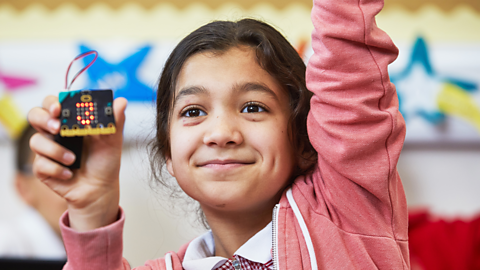You can no longer submit your playground survey data, but you can still do all of the activities with your class.
A fun whole class DataInformation collected for use elsewhere. collection activity that uses the BBC micro:bit as a ThermometerA device that measures temperature. to record surface TemperatureA measure of how hot something is. in four different areas of the school playground. Pupils will answer the question:
How does the surface material of our playground affect the surface temperature?
Download a poster for your class to keep track of your results here.
Watch the video
Big Manny: Hi, everyone. Welcome to the playground. Now, today I'm going to be showing Shereen how to use her BBC micro:bit to collect some very cool information about this very location.
Shereen: That’s right. We're going to be carrying out a scientific investigation.
Big Manny: So to get started, we've got this really interesting question from Katie from Larbert in Scotland.
Katie: How does the surface material of your playground affect the surface temperature?
Big Manny: Okay, so it's up to us to try and answer Katie by measuring and comparing the temperature of different types of surfaces in the playground using only the micro:bit. So we're going to measure two surfaces made from natural materials. That just means that they come from the natural environment.
Shereen: So like soil, bark and grass?
Big Manny: Yeah, exactly. And we’re going to measure two surfaces made from synthetic materials.That means that it was produced by humans. So, for example, things like metal, tarmac and astroturf.
Shereen: So two natural and two synthetic? I think I got it.
Big Manny: Right, so the first thing we need to do is use the MakeCode editor to program the micro:bit and then we can turn it into a thermometer. Let's go.
Shereen: Okay. Let's do this… Oh, that was super easy. I bet you could do that standing on your head.
Big Manny: Yeah. So the code for this is actually quite simple. So I collected my data earlier on, from four different areas, all in the sun. Now, your challenge is to measure and record your readings accurately. If you do, then we should see the same patterns in the temperature data.
Shereen: Let's go.
Big Manny: So we need to make sure that the micro:bit is flat on the surface because if it's not, then the sensors are going to take the temperatures from your hand.
Shereen: Okay, cool. 1, 2, 3…58, 59 and 60. 1, 2, 3…58, 59, 60…59, 60. 1, 2, 3…58, 59, 60.
Big Manny: Okay, so it looks like your results are slightly different from mine but we can still seea lot of similarities within the patterns of the data and I think we're ready to answer Katie’s question now.
Shereen: Yeah, so it seems like the natural materials in this playground are cooler than the synthetic ones. But why is that?
Big Manny: Well, on average, once they’ve heated up, synthetic materials tend to stay hotter for longer.
Shereen: So that's why it's important to choose the materials we use carefully. The people who design playgrounds need to make sure the surfaces don't get too hot when it becomes sunny.
Big Manny: Exactly. And because our planet is heating up this kind of data can be very important to architects and designers when they’re planning our homes and our communities as well. Sometimes, even small temperature changes can have a big effect, especially on things like plants and wildlife. Now that you know what to do, what are you waiting for?
Shereen: Have a go yourself and see what temperature patterns you can find in your playground.
Both: Bye.
How to complete the activity
Download the resources. documentDownload the resources
Download the teacher instructions, pupil worksheet, class poster, curriculum map and parent/carer letter.
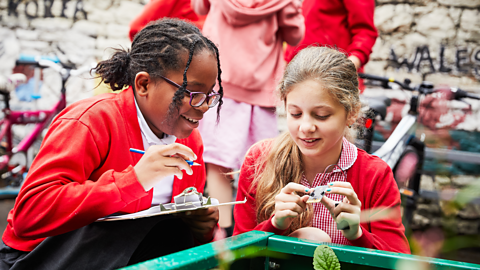
Program the micro:bit. External LinkProgram the micro:bit
Visit the Micro:bit Educational Foundation's how to guide for coding instructions or to download the code.
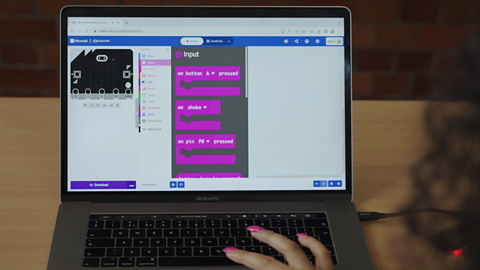
Analyse your class data. External LinkAnalyse your class data
Discuss findings, make links and consider data-led actions.

Playground survey teacher notes
- To complete this survey activity you will need the helpful teacher instructions and pupil worksheet.
- This activity is primarily a science investigation linked to the thermal properties of different materials. Pupils will have a chance to think about fair testing, taking and recording repeated measurements and analysing their data.
- It is a great opportunity to use and develop mathematical skills including data handling (data tables, bar charts, line graphs) and simple statistical analysis (calculating averages, percentages).
- It is also a good example of geographical fieldwork, to enable pupils to answer geographical questions about the local area.
- We would love to see how your class is getting involved with the BBC micro:bit playground survey. Why not share updates about your activities on social media and let us know by tagging @BBC_Teach and using #BBCplaygroundsurvey
Topics covered
- Computing/ICT: InputData sent to a computer for processing such as button presses and sensor readings. and OutputData sent from a computer such as information shown on the LED display.; Using a SensorAn input that senses things in the real world, such as movement, temperature, and light levels.; Events.
- Science: Thermal properties of materials, taking and recording measurements; HabitatThe places where plants, animals and other living things exist. (sunny and shady) linked to plant and animal diversity and classification.
- Maths and Numeracy: Averages.
- Geography/Humanities: Weather; Human/physical features; Carrying out fieldwork to answer a question.
- Design and Technology: Applying their understanding of computing to ProgramA set of instructions written in code that performs a given task., monitor and control their products; Designing products to fulfil a design brief and/or solve a problem.
Suggested learning objectives
- Introduction and planning: To compare and group together everyday materials on the basis of their properties, including their thermal conductivity (Science).
- Optional coding: To combine CodeInstructions written in a way that a computer can understand. blocks to create a program; To understand input/outputs; To understand simple VariableA container for storing data which can be accessed and updated while a program is running. (Computing/ICT).
- Fieldwork: To measure temperature using appropriate standard units (Maths and Numeracy); To take measurements, using a range of scientific equipment, with increasing accuracy and precision and take repeat readings when appropriate (Science).
- Data analysis and recording: To recognise that changes in materials affect their properties and uses (Science); To calculate and interpret the mean as an average and interpret information in the context of an enquiry question (Maths/Geography/Humanities).
Suggested extension activities
- Science: Try the investigation on sunny/cloudy days, in different seasons and after changes to the playground; explore different materials back in the classroom to find out more about their thermal properties.
- Maths and Numeracy: Present the data in a range of different ways (including different types of graph); calculate percentage differences.
- Geography/Humanities: Create maps of the playground showing the location of different surfaces, sun or shade; carry out further fieldwork/surveys to answer similar geographical questions.
- Design and Technology: Design a case or box to protect the microbit and to support the user to operate it correctly as a thermometer.
- Art/English: Design a newspaper advert for a micro:bit thermometer; Write to someone in relation to a playground re-design.

More activities from the playground survey
Investigating biodiversity. videoInvestigating biodiversity
Use the micro:bit Biodiversity Counter program to investigate the number of different species of plants and animals in your playground.
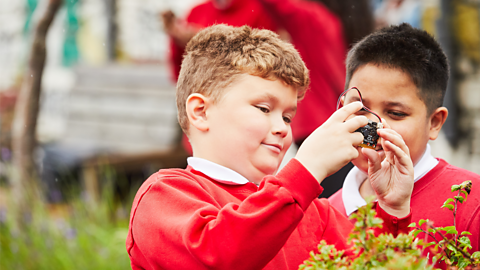
Measuring area. videoMeasuring area
Measure distances to calculate the area of your school playground using the clever micro:bit Distance Calculator program.
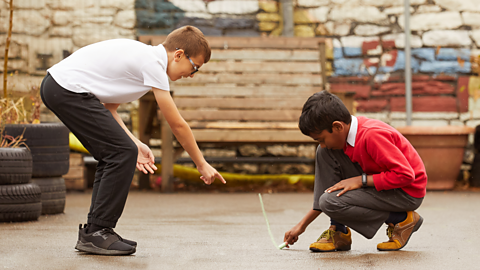
Playground survey glossary
A helpful glossary to increase your confidence when teaching the seven BBC micro:bit playground survey activities.
